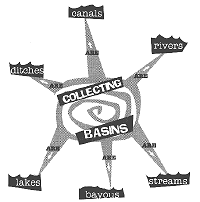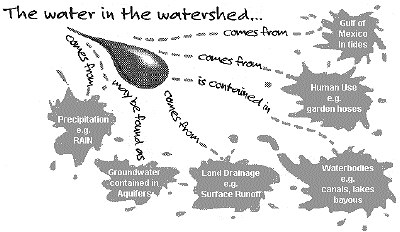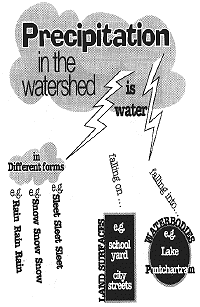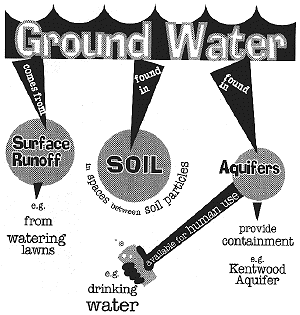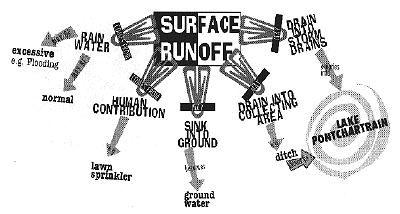ObjectivesBasin: Guided ImageryFacts about the BasinWhat is a Watershed?Where does the water come from?PrecipitationGroundwaterSurface RunoffActivities |
|---|

Pontchartrain Basin:
A Watershed
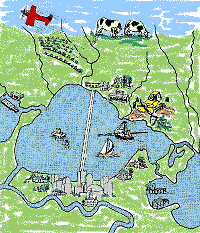
Objectives:
- Define a watershed.
- Describe the relationship between land and water in the watershed.
- Describe the Lake Pontchartrain Basin watershed.
- Read and understand the features on a topographic map.
Click for a larger view.
Multiple Intelligences Learning Activities:
Verbal/Linguistic: - Write a script promoting the Lake Pontchartrain Watershed.
Logical/Mathematical: - Construct individual maps of the Lake Pontchartrain Basin.
Visual/Spatial: - Design a watershed and demonstrate its function.
Create posters and programs to publicize and promote the Lake
Pontchartrain Watershed.Bodily/Kinesthetic: - Dramatize a trip through the Lake Pontchartrain Watershed.
Interpersonal: - Work in cooperative groups designing a watershed, conducting a
survey, and writing, promoting, and producing a play.Intrapersonal: - Verbally express feelings about the Lake Pontchartrain Basin after listening to a guided imagery.
The Lake Pontchartrain Basin:
A Watershed
Guided Imagery
Imagine you are a small stream, a mere trickle of bright clean water, snaking, twisting and turning on your way to the sunny southern coast. Your water spills over rocks and pebbles, smoothing the rough multicolored stones with the force of your rushing water. The soils and sediments you push along the bottom are reddish brown in color, arising from alluvial deposits containing iron compounds. Plop! Plop!... small rocks skip across your surface. Plop! Plop! Smooth stones first skim and then break the surface as they start to sink. Ripples mark the spot; each one larger than the first. The small boys and girls skimming stones turn their attention to other things, and you race down bluff terraces between craggy tree roots and sandy sediments to another dark pool. Here the woods smell of pine. The earth, moist and dark, is covered by thin brown needles and prickly cones. Beside you, a squirrel picks up a newly fallen cone and with great speed tears into the sticky interior in search of newly formed seeds, an afternoon snack perhaps. Your water is dark and quiet; the Native Americans name you, "Tangipahoa." Along your way to the lower coastal plain you now dip, rush, twist and turn, all the while collecting water from the land. Rain dampens green pasture land which harbors black and white dairy cows; it rolls off the purple thistle plants, and the glistening drops cascade over the dark green leaves, finally plunging to the rich moist ground. There, drops gather and form with other drops into a small rivulet which races to the water's edge. As this water enters your gradually enlarging stream, it feeds the bright green grasslike algae growing at the muddy edge-- where bubbles of oxygen float free like balloons during the late night hours--where tiny fish nip at the hairy wisps; snails crawl on the cushiony mat, and black water bugs scamper, dart and spring off the bouncy surface. You now enter Lake Pontchartrain: Lake Pontchartrain, the collecting basin of a large watershed. Not only the water from your own Tangipahoa watershed, but drainage from Lakes Maurepas and Borgne and other small rivers...the Amite, Tickfaw, Tchefuncte, Bogue Falaya, West Pearl Rivers and Bayou Lacombe all contribute water to the great lake, Lake Pontchartrain, where all converge to become one: The Lake Pontchartrain Basin.
